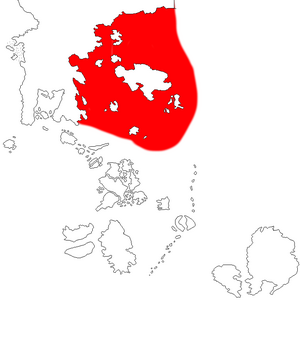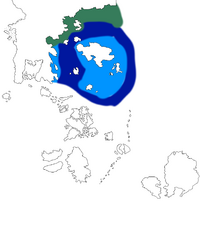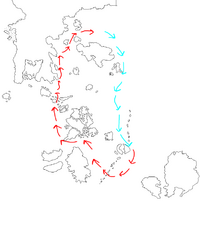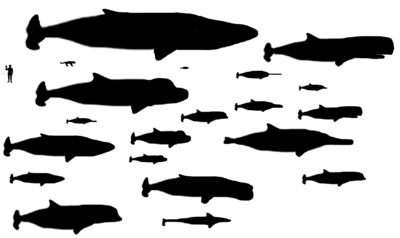Asterhaf
Asterhaf (literally, "The Eastern Sea") is a vast oceanic region located east of Scandera and northwest of Asterland. Known by various names including Nardsja, Svarthaf, Kakto Dour, and Ishashi'mo (meaning "The Northern Sea," "The Black Ocean," "The Northern Ocean," or the "Sahsi/Scanderan Sea"), the area is considered federal waters by the Absolute Royal Federation. Although the Federation does not assert as stringent a claim over this ocean as it does over the entire Vattnafalten in the south, and it does not enforce the entire region as within its exclusive economic zone (EEZ).
Asterhaf is bounded by Scandera, notably Imeriata, Vedian, and the northern ice plains to the east, and centrally surrounds Asterland and Salywa. The southern reaches include notable locations such as the island of Dragon Grave, Taranaka, and Salmo, with the far north defined by the Cairn Shore.
The sea is distinguished by its profound central depth, a result of tectonic plates gradually separating Asterland from Scandera. This geologic activity not only fosters a deep-sea environment but also leads to frequent volcanic activity, contributing to the formation of several small island chains. These islands are primarily inhabited by Scanderans, Scanderianized natives, Giels, and other ethnic groups collectively referred to as "Havsavalk" by federal authorities. Due to historical Scanderianization, these groups have either assimilated or been replaced by Scanderan settlers over the centuries.
Economically and militarily, the region is crucial, serving as a major transport hub connecting Asterland, Salywa, and Scandera. Although not as heavily utilized as the Vattnafalten, the sea has historically been vital for regional trade, especially the routes from Asterland to the Scanderan Northern Ice Plains and down to Scandera proper. Today, industries such as fishing and whaling remain significant, complemented by emerging oil drilling activities. Strategically, the region hosts substantial naval bases for the Federal and Royal fleets, ensuring control and providing a strategic point from which to defend the southern territories.
Geography
The region's geography is influenced by the divergent continental drift between the southern Scanderan and Asterland shelves, which has created a notably deep ocean. Additionally, the warm Vattnafalt Stream moderates the climate, causing heavy rainfall on the eastern Scanderan coast and contributing to the region's temperate and Arctic rainforests. Large meltwater runoffs from the islands enrich the sea with minerals, fostering annual algae blooms that support extensive marine life.
The sea is divided into five distinct areas: the northern kelp forests, the dense pine mangroves of eastern Scandera, the shallows of Asterland, the volcanic islands, and the deep black sea. These regions are interconnected, facilitating large-scale migrations of marine wildlife.
Scanderan Coast
This extensive coastal area features kelp forests and pine mangroves, hosting a biodiverse array of species, including fish, seals, walruses, cetaceans, bears, and semi-aquatic mammals. Northern sea lizards are also present, though in smaller numbers compared to the southern Vattnafalten.
The Cairn shore
At the extreme north, the "Cairn Shore" or "Brasstrand" is a cold, rocky landscape dominated by a massive kelp forest. It supports a rich ecosystem of walruses, dolphins, seals, small whales, and various other marine species. Historically, it has been home to several civilizations, including ancient pyramid builders and cairn builders, known for their necromantic practices, which led to their eventual demise at the hands of Scanderans. The modern population is somewhat Scanderianised but they also keeps a lot of traditions and languages of their Cairn builder forebears.
Eastern shallows
Surrounding Asterland, this area includes shallow sandbanks, seagrass meadows, and kelp forests, and lacks the profound depths found in the central sea. However the most known area is the south western coast, known for the yearly meltwater runoffs that causes the yearly algae blooms have resulted in a rather unique floral system, the blooms tends to severely impact the seabed here and kills off most of the flora but when they have either died off or been eaten by migrating animals is the sandy shoreline fertilized once more and is quickly regrown by seagrass and kelp, this have resulted in a large number of yearly but fast growing species that spread out widely but not very tall, resulting in a shore lacking most of the larger fauna that is common elsewhere.
Islands
The islands between Scandera and Asterland are volcanic in nature. Their fertile soils support birch forests, and seasonal meltwaters contribute to significant algae blooms, attracting massive schools of fish and their predators.
Deep Sea
Characterized by its depth, the deep sea region is the site of significant volcanic activity and hosts large marine fauna, including kraken squids and sea dragons. Although modern navigation is safer, the area remains treacherous due to its predatory inhabitants.
Biology
Sea Lizards
Although not as prevalent or ecologically significant as their southern counterparts, sea lizards have managed to establish populations in Asterhaf. The colder temperatures in these regions generally deter serpent whales, preventing their expansion into the north. In Asterhaf, three main clades of sea lizards are represented:
- Ichthyosaurs: The ichthyosaur known as the "Nordlig fiskadla" or "Northern Fish Lizard" is found in small populations in the deep ocean and the far north. These lizards primarily hunt cod and other mid-sized fish.
- Kelp Forest Sea Lizards: The most common clade in the northern regions includes long-necked sea lizards that inhabit kelp forests and mangroves along the Scanderan coast and further north. These lizards are generally more robust than their southern relatives and have developed tissue analogous to blubber in mammals. Their long necks allow them to function as large ambush predators within these environments.
- "Likataradla" or "Corpse Eater Lizard": This clade comprises short-necked sea lizards that are widespread across the seas. These slow-moving scavengers primarily feed on carrion, and commonly drive off smaller whales and sharks from their kills.
Sea dragons, traditionally viewed as a distinct group, are increasingly classified as a subset of sea lizards by federal researchers. These creatures are found in the northern oceans, where they often inhabit shallower coastal waters. Sea dragons are formidable, fast predators that make their homes in underwater caverns, though they have been known to create their own burrows would these be lackign. Despite their adaptability, sea dragons must surface to breathe, which limits their range and prevents them from venturing into the deepest parts of the ocean dominated by whales.
As a result, sea dragons remain the largest apex predators in coastal regions. They frequently engage in territorial disputes with larger whales, a theme commonly depicted in local myths and legends. In deeper waters, sea dragons often defend their territory against encroaching whales, and even "corpse eater lizards" can be seen entangling with these powerful creatures. While sea dragons have also migrated south, they have struggled to establish populations due to the dominance of venomous serpent whales, which often kill intruders, though such encounters frequently result in the serpent whales' own demise.
Cetaceans
In the marine ecosystems of the Asterhaf region, fish, plankton, and various species of kelp and seagrass form the foundational elements of the food web. However, the dominant species within these ecosystems are the cetaceans, with only sea lizards, Krakens, and Sea dragons capable of rivaling their dominance. Cetaceans range in size from medium-sized semi-aquatic predators that inhabit the deep pine mangroves of the eastern coast and primarily consume fish, to mid-sized seals—referred to as "sea wolves." These sea wolves are closely related to the river wolves of the Scanderan interior and represent a distinct clade from most other whales, retaining a more primitive form and not fully adapted to aquatic life like their more distant relatives.
It is important to note that in Scanderan terminology, the term "whale" is used more broadly than in many other languages. It encompasses not only cetaceans but also serpent whales, ichthyosaurs, and even large sharks and fish. The only significant exceptions to this category are non-ichthyosaur sea lizards and krakens. The term "whalefish" is used specifically to refer to whales, dolphins, and porpoises, although it typically excludes sea and river wolves.
Among the marine giants, the blue whale stands out as the largest living animal in the entire federation. Its immense size makes it a source of awe and inspiration across federal territories. While the blue whale represents the apex size of filter feeders, several smaller species of filter feeders also inhabit the sea. These species often migrate through the deeper waters but frequently travel eastward to feed on algae blooms. They may feed directly on the algae or on the plankton swarms that are attracted to the blooms.
In addition to filter feeders, many whales have evolved to prey on other marine mammals and reptiles. Species such as orcas are generally not a threat to humans unless provoked, and large predatory whales that target other filter feeders or fish eaters usually avoid humans unless they interfere. However, some mid-sized species are known to be dangerous and may actively hunt humans. For instance, the so-called "Banefish" is notorious for preying on seals, fish, and even other whales of similar size, and may include humans as prey if the opportunity arises. Another dangerous species, the "fighting fish," is highly aggressive, particularly the males, which exhibit near-suicidal aggression to protect their pods and they are known to attack even sea dragons on sight. While attacks on humans by these species are opportunistic rather than targeted hunting, they still pose a significant risk to those who come too close.
Specialist fish-eating whales are noted for their long snouts, including well-known dolphins and other larger whale species that have independently developed similar adaptations. These can range from the small mangrove dolphin, about the size of a human arm, to massive predators comparable in size to small ships. Species such as the cachalot are specialized in hunting large squids, krakens, and ammonites that inhabit these productive seas. These are commonly referred to as "squidslayer whalefish" or "blackafiskbane valefisk" in Imerian. It should be noted that some of these adaptations are the result of convergent evolution rather than shared ancestry.
Whales have had a profound impact on the cultures surrounding Asterhafet. Whaling has been a prevalent practice among these cultures, with some relying on it alongside fishing and seal hunting as a primary food source in the far north. Whales are frequently featured in local mythology and stories, often having Gods take the shape of whales in myths but also being worshiped in their own right in more primitive cultures. Whaling sacrifices are a common religious practice, and whales are prominently featured in regional heraldry and art. Scanderan sea lords, in particular, often include predatory whales in their coats of arms.
Fish
Fish are a fundamental component of the Asterhaf ecosystem and play a crucial role in the diet of nearly every animal living in or around the sea. They constitute a significant portion of the region's ecological diversity and occupy almost every ecological niche, with the exception of the largest apex predators, such as sea dragons, whales, and krakens.
Fish in the Asterhaf range in size from very small species that feed on algae and plankton to medium-sized fish that are both predators and herbivores. The largest fish, including both predatory species and herbivores, can rival smaller whales in size. Sharks and other large predatory fishes are known to hunt and feed on seals and smaller whales.
Fish are integral to the ecosystem, and almost every other clade of animals in the region relies on them in some capacity.
Semi aquatic mammals
Semi-aquatic mammals play a crucial role in the ecology of the Asterhaf, inhabiting the shores of the region. Among these mammals, the top predatory niche is often occupied by various species of swimming bears. This includes the polar bears of the far north and the "vatnabjarn" (Water Bear) of the Scanderan mainland. Smaller bears, such as the "asterabjarn" (Eastern Island Bear), are also present but are typically found in the Scanderan shoreline and islands. In the far north, where polar ice facilitates the dragging of prey ashore, these bears avoid potential threats from predatory whales.
In addition to bears, the Asterhaf is home to large populations of walruses, seals, and sea lions. While these mammals are specialized for aquatic hunting, they are also capable of retreating to shore to avoid danger. It is important to note that not all seals in this region are predatory. Some have evolved as omnivores, primarily consuming kelp and seagrass, and supplementing their diet with various crustaceans, mollusks, and small fish. Walruses, on the other hand, are exclusively adapted to feed on mollusks and crustaceans.
The eastern shore of Asterland, characterized by algae blooms and a highly circular life cycle, sees fewer marine mammals compared to other regions. However, several smaller seal species still inhabit this area. In contrast, the northern range of the continent, similar to Scandera, supports massive populations of walruses and seals. These populations are exploited by local human communities, although diversity on the southern shore remains relatively limited.
Among the notable species in the region is the "Hoch sjalajan" or "High Sea Lion," which reaches sizes comparable to larger bears. This impressive predator is known to hunt whales and sea lizards that venture into the kelp forests.
In addition to these species, the Asterhaf is home to sea otters and coastal martens, particularly in the Scanderan pine mangroves. The coastal martens, also known as "dykmard" or "diving martens," are arboreal predators that dive into the water to capture fish, employing a hunting method similar to that of birds. This niche is shared with certain lynxes, although the specific prey targeted by each species may differ.
Cephalopods
Cephalopods, including ammonites, nautiloids, squids, and octopuses can all be found in the Asterhaf and smaller cuttlefish, are prevalent in the southern regions. These cephalopods serve as common prey for coastal human populations, as well as for a range of marine predators such as larger fish, reptiles, mammals, and even birds.
An exception to this general trend is represented by the giant squids and nautiloids, often collectively referred to as "krakens" by many in the federal regions around the sea. While some of these colossal creatures are known to hunt smaller fish, and a few rare species act as mid-sized ambush predators, the predominant role of cephalopods in these ecosystems is as small prey animals and predators of the smallest fish species.
The term "kraken" specifically denotes the truly massive deep-sea cephalopods encountered infrequently. Historically, krakens were considered a distinct group. However, this classification is largely artificial, as these gigantic creatures do not share a common recent ancestry and are often more closely related to various smaller cephalopod species than to eachother.
Crustaceans
Crustaceans in Asterhaf exhibit similarities to those found in the southern vattnafalt, with groups such as crabs, lobsters, shrimp, and crayfish playing a crucial role in the ecosystem. These crustaceans are important both as prey for various predators, including small fish, and as a significant dietary component for mammals and fish.
In addition to their ecological importance, crustaceans hold cultural significance in the region. Many Scanderans celebrate important holidays by feasting on crustaceans, reflecting their integral role in local traditions and cuisine.



